Care Mapping with Atlas of Care
Care mapping provides a unique and valuable tool for integrating relationship-centered care into the daily practices of Equal Care Coop. By emphasizing the importance of existing support networks, care maps help build stronger care teams, create more meaningful care experiences, and ensure that the individual’s identity and well-being remain at the heart of the care process. This methodology not only enhances care planning but also fosters a deeper understanding of how to support individuals in ways that honor their connections, relationships, and place in their community.
About Care Mapping & Atlas of Caregiving
From birth to death, people are embedded within various systems of care and support, ranging from large institutions to more personal, informal networks. These systems are fundamental to human well-being and play a critical role in maintaining a sense of identity and belonging. While greater independence is often achieved in adulthood, the reliance on these broader systems of care remains essential. Even when not directly engaged in the giving or receiving of care, there is comfort and security in knowing that these support networks are available. Given their significance, one might expect a more widespread understanding of their impact; however, many people are not accustomed to viewing themselves as part of the care networks that shape their lives.
Atlasofcaregiving offers a structured methodology for visualizing and understanding these interconnected systems. It provides a way to recognize the individuals, relationships, and institutions involved in care and support, revealing the broader networks that often remain unseen. By creating a visual representation of these networks, care mapping enables individuals and communities to better comprehend the flow of care, identify areas for improvement, and strengthen existing relationships.

This guide introduces the Care Mapping methodology, offering a framework to deepen understanding of how care systems function and highlighting its practical applications for both individuals and communities. By applying this approach, care networks can be better understood, gaps in support identified, and stronger, more resilient systems of care developed. The best way of learning how to do care mapping is to do your own personal care map.
Mapping personal care networks
The Atlas of Care offers a straightforward process for mapping your care networks. Start by listing the people you support, those who support them, and those who support you. Using pencil and paper with simple symbols you can create a visual representation of your care and support network.
See video below.
Informal Care networks are complex living systems, so they can never be represented in their entirety. But we don’t need to make a comprehensive care map to learn something useful. Drawing key individuals in your support network, showing their connections and proximity to you, helps you understand how people influence each other. Even small changes can lead to positive outcomes for you and those who matter to you. These changes might involve:
Making regular phone calls to someone supported by someone close to you.
Informing someone that they are in your care map to make them aware of their significant role in others' lives.
Asking for help more often instead of always offering to help.
Spending more time with those who provide you with nourishment.
Cultivating closer friendships with people who live nearby.
Saying "no" to some people more often.
By examining your care map, you can see how these simple actions can profoundly impact both you and the people who matter most to you. Your care map often reinforces things you already knew were worth doing or avoiding. However, it's essential to recognize that care mapping also involves emotional work, as it can evoke feelings of guilt or motivation.
For a video on using your care map see below.
Last updated
Was this helpful?

